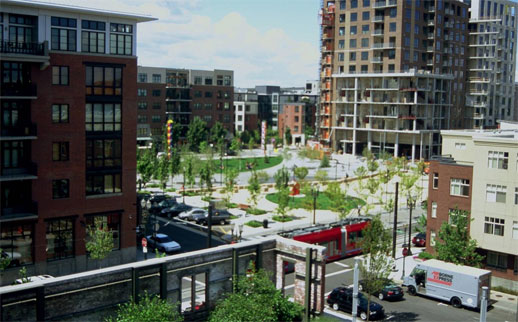New grant program to support smart development around transit lines is open for business
Webinar info updated below: A program created in the 2012 transportation law to help communities plan for transit-oriented development is open for business — and T4America is ready to help your community win some of that grant funding.

Building structured parking, public amenities and pedestrian-safe streets are part of the public infrastructure needed for successful economic development around transit.
One of the few bright spots in MAP-21, the 2012 update of the federal transportation program, was the creation of a small pilot program of competitive grants for communities trying to support better development within their new transit corridors — one smart way to boost ridership and support local economic development. *Funds can also be used on projects that increase capacity on existing transit lines, but for the most part, these funds will support planning for new transit lines.
It’s a small program, but one that could have a huge impact in the recipient communities. The Federal Transit Administration announced late last week that they’re now accepting applications from transit agencies until November 3, for a total of almost $20 million in available funding (for the two years since MAP-21 passed).
(Speakers updated 9/23) With the FTA open to receive grant applications, T4America has organized an online session to explain the program, how it works, and what kind of applications FTA will be looking for. We’ll have Homer Carlisle, professional staff for the Senate Banking, Housing and Urban Development Committee, John Hemplemann, Founding Partner of Cairncross & Hempelmann, as well as experts from Transportation for America to discuss this new program. Find out more information about this webinar taking place on Friday, September 26, and register today right here.
According to the notice from FTA, “the grants will fund comprehensive planning that supports economic development, ridership, multimodal connectivity and accessibility, increased transit access for pedestrian and bicycle traffic, and mixed-use development near transit stations.”
This type of planning has been used successfully in transit corridors such as the Foothill Extension of the Gold Line which connected 11 small cities east of Los Angeles, the West Corridor that connects Denver with the suburban community of Lakewood, and the Green Line which connects Minneapolis to Saint Paul. As shown in these cases, planning for development along the entire corridor – rather than just one station area at a time –can attract private-sector interest as well as stronger community consensus by creating a complete picture of the development opportunities presented by the new transit line.
Rail and rapid bus lines often cross multiple jurisdictions, which can make coordinated planning of development at stations difficult. As an example, while most would agree some share of housing along such lines should be affordable to low-wage workers, what if none of the cities along the line choose to provide for it as part of new development at their station areas? What if one of the cities chooses not to allow walkable development at all around their new station, undermining the ridership potential of the entire line? Coordinated planning involving all of the jurisdictions along a corridor can help to address these issues at the front end, to capture the maximum development potential of the line.
FTA will focus on funding the kind of planning that would not occur without federal support. Grants will fund planning around an entire transit corridor, not just individual station areas, particularly corridors where there are significant challenges to transit-oriented planning, low levels of existing development, or limited local financial capacity.
Transit agencies that are building new transit systems or upgrading existing ones will be eligible to apply for new planning grants, in partnership with local land use agencies and the private sector, to help them efficiently locate jobs and housing near new transit stations, boosting ridership and increasing the amount of money gained back at the farebox.



















